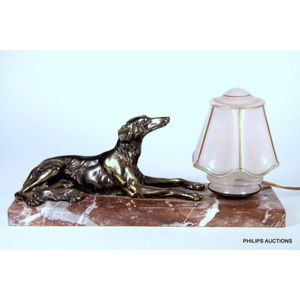Art Deco Borzoi Table Lamp
You must be a subscriber, and be logged in to view price and dealer details.
Subscribe Now to view actual auction price for this item
When you subscribe, you have the option of setting the currency in which to display prices to $Au, $US, $NZ or Stg.
- Bronze - An alloy of copper and tin, traditionally in the proportions of about 9 parts of copper to 1 part of tin.
The discovery of bronze in Western Asia in the 4th century enabled people to create metal objects which were superior to those previoulsy possible because of its strength and hardness, and it has been used throughout the world for weapons, coins, tools, statuary and other decorative items.
It is very fluid in a molten state, and its hardness, strength when set, and non-corrosive properties makes it most suitable for casting sculpture. - Circa - A Latin term meaning 'about', often used in the antique trade to give an approximate date for the piece, usually considered to be five years on either side of the circa year. Thus, circa 1900 means the piece was made about 1900, probably between 1895 and 1905. The expression is sometimes abbreviated to c.1900.
- Art Deco Period - The Art Deco period was a cultural movement that emerged in the 1920s and 1930s, and was characterized by its emphasis on modernism, luxury, and elegance. The name "Art Deco" comes from the Exposition Internationale des Arts Décoratifs et Industriels Modernes, a large exhibition held in Paris in 1925 that showcased the latest trends in decorative arts.
Art Deco was a reaction against the ornate and elaborate styles of the previous era, and reflected a new modern sensibility. It was characterized by streamlined, geometric shapes, bright colours, and the use of new materials such as chrome, glass, and Bakelite. Art Deco designers sought to create a sense of luxury and sophistication, often incorporating expensive materials such as ivory, marble, and rare woods.
Art Deco had a significant impact on a wide range of artistic fields, including architecture, fashion, graphic design, and interior design. Some of the most iconic examples of Art Deco architecture include the Empire State Building in New York City, the Hoover Building in London, and the Palais de Chaillot in Paris.
The Art Deco period came to an end in the 1940s, as World War II and changing cultural trends led to a shift in artistic styles. However, Art Deco remains an important influence on design and art, and continues to be celebrated for its modernist sensibility and glamorous aesthetic. - Spelter - Spelter was the name given to an alloy of zinc and brass or copper used in the 19th century for statuary and lighting. It is a brittle bluish-white metal. It was used as a cheap replacement for bronze, but being brittle easily breaks and can't be repaired. When finished it can often be mistaken for bronze, but if discreet a scratch on the base displays shows a greyish colour, the metal is spelter, if a golden colour the metal is most likely bronze.
This item has been included into following indexes:
Visually similar items

Two sterling silver sauce boats & 2 sauce ladles hallmarked Sheffield 1966 & 1964 (Viner's Ltd Emile Viner), 267 grams approx

A 9ct yellow gold solid white opal and diamond ring, one oval solid white opal 7 x 5 mm with one round diamond, 0.01ct mounted in a yellow gold band, size M Wt. 2.1grams

Swarovski Crystal SCS young blue Whale, #1096741, with original box, 7 cm high approx.

An Art Deco spelter antelope, circa 1920s, a recumbent antelope, its head inclined to the rear, in lustrous bronze colours and raised on a pale apricot marble base faced with cream and figured brown onyx, height 18.5 cm, width 26.5 cm, depth 11 cm
